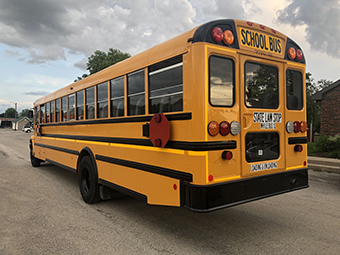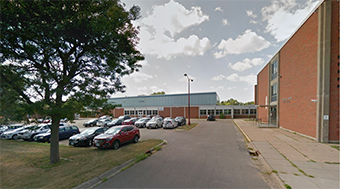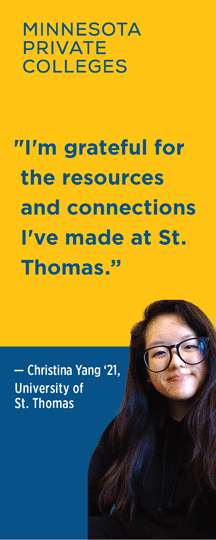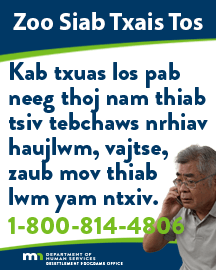I grew up in north Minneapolis and attended Minneapolis Public Schools throughout my teenage years. My family arrived in Minnesota in 1993 when I was ten years old and placed in fifth grade at Bancroft Elementary School in south Minneapolis. My younger siblings also attended the same school with me, making it easier for my parents and extended family members to help us with bus registration and medical check-ups for schooling – where all siblings enrolled and rode the same bus to the same school.
As Hmong refugee students, we often got picked on by students at school. We didn’t speak any English, and often inside the yellow school bus, the kids who always sat in the back of the bus made fun of us. To us they said, “mother &%$#@*,” “chink,” “you wanna fight, you know Kungfu, you related to Bruce Lee,” or “go back to your own country.” Most of this name calling and being laughed at occurred in the school bus, and mostly was done by male students. We came home and told our parents, but they couldn’t do anything since none of us spoke English. My mother said, “Just try to find any seat in the front of the bus and keep your head down. Don’t talk to them, even if they laugh at you or call you names. Most of the time, you don’t know what they said, so words won’t hurt you, just ignored those kids and be good students in your class.”
I graduated from Bancroft Elementary and transferred to Olson Middle School in Minneapolis. My younger brother followed me a year after to Olson. I thought that going to a new school would be a less negative experience of dealing with bullying by students in the bus. Boy! I was wrong. The same thing happened at Olson Middle School. If you grow up in north Minneapolis, you were more likely to be riding a school bus with students to the same public school. Even when you were the first one to come at the corner of the street waiting for the bus, the students came later and would buzz in front of you to go up into the school bus. The bullying ones often go to the back of the bus and make loud noise. None of us Hmong students in the same bus would take any back seat. Sometime the kids threw their shoes at us, and sometimes they argued and fought each other in the back of the bus.
I was one of those quiet Hmong students who just wanted to learn, do well in class, and hopefully go to college after graduating from high school. I remembered at Olson Middle School, we didn’t have any full-time Hmong teachers or staff members. The only two Hmong staff were half-time in English Second Language (ESL) class.
During lunch hour, most of the white students sat together at one corner, the black students sat at the front row table, and the rest of our Hmong students were assigned to the back of the lunchroom. Mr. A##, a staff member, was assigned to supervise the lunch hours by calling each student group’s table to line up for lunch if the students were behaved well enough; often called the black students’ tables first and skipped most of the Hmong students’ tables. Even though my Hmong friends and I were the quiet ones, sitting in the back of the lunchroom, Mr. A## barely paid attention to our tables. You might wonder why we didn’t pick the front row? Well, in the school bus was one culture, and in the lunchroom another very different culture. The black students would go to the back of the bus so they could have all the fun, and at lunch hours in school, Mr. A## only paid attention to those in the front row, so most of the black students picked the front row so they could be called to get their lunch first. There were times that Mr. A## didn’t even bother to call our table, we just snuck out to line up to grab our lunch before the good food ran out. We shared our lunch experience with the Hmong ESL teachers for years, and they finally brought this issue to the administrators. For a short week, Mr. A## started to call our table to line up first. After a week, the culture went back to normal the way it used to be. If there were no Hmong staff, who else would advocate for the Hmong students? No one. The teachers were always busy managing students’ behavior in the classroom while trying to teach us something. There was no one else we could turn to for support at public schools.
I remembered in seventh grade in Ms. C###’s math class; she dropped her white chalk on the floor. While she bent down to grab the chalk, the students made fun of her rear end size. They were pointing and laughing at her butt. She just told them to be quiet and then continued writing the math problem on the chalkboard. Most of the day in ,ath, English, science and social studies classes, the teachers spent more time managed the students’ behavior in the classroom than teaching us about the subject. I often observed that my teachers weren’t only there to teach, but babysitting was a big part of their job.
My cousin tried to recruit me to join his Hmong boys’ gang. There was this one day that I stayed after school to help out as the Hmong students prepared for the Hmong New Year event. I didn’t know what after school bus I should take home since this night route was outside of my regular bus schedule. My cousin told me that I should take the same bus with him to his house, and he would ask his mom to drop me home, since I didn’t know how to get home. That evening, I sat with my cousin inside the bus, he showed me his Hmong knife inside his backpack. He told me that, “We know a lot of kids at this school bullying Hmong students, especially those like you who don’t speak English well. If you join our gang, we will protect you at school like brothers. We’re not doing any bad stuff like stealing cars or fighting each other. We’re just a second helping hand to protect our Hmong brothers and sisters. So, we need you to join us and fight those kids if you ever get bullied or punched by them in the hallway.” I didn’t know what to say to my cousin. I was chicken and never got to join his group. I was even more shock to see his parents’ Hmong knife inside the backpack. He said, “I’ve never used the knife, I only leave it inside my backpack in case I walk home alone, and some kids jump on me.” In those early days, the only reason Hmong kids joined gangs was for protection at school, not like today’s gangs divided by colors and groups. There was this one time that I walked home alone from summer school, and I got jumped by three kids in north Minneapolis. They punched and kicked me and searched through my backpack. They laughed at me while I was on the ground. After they didn’t find anything valuable inside my backpack, they threw the backpack at me and left.
Growing up in north Minneapolis and attending public schools was not easy. My parents had never attended any of my parent/teacher conferences and/or meetings. They didn’t speak English, and they would not know what to discuss with my teachers. In my parents’ mind, they placed the “teachers” as the mentors and guides at school, that the teachers should be my parents and I should listen to them and do whatever they say. Although my parents didn’t have any formal education, they always made sure that my siblings and I finished our homework assignments each night. If we brought home any “A” grade, we would receive $5 for each one, a way to inspire us to study hard at home and school.
I felt that the majority of my teachers didn’t pay much attention to my education since I was the quiet and well-behaved student and didn’t need the attention from them. I’ve observed my public school teachers became more of babysitters instead of being their role as “teachers.” The only thing I really learned about America history and culture was from my ESL teachers. I loved going to Mr. Michael Yang’s class at Edison Senior High School. He was one of the three Hmong teachers at the high school level who truly supported the Hmong students. In 1997 there was something that happened at Edison High School and the Hmong students protested outside of the school building. I was only a freshman at the time, and I didn’t know what was happening between the students, teachers, and the principal. I recalled many Hmong students held signs outside of the building and demanded something be changed for the Hmong students.
I remembered learning about Rosa Parks and the bus boycott movement from social studies class. I asked my female ESL teacher why black leaders fought so hard to have a sit in on the bus, and why the black students in my school bus always go to the back of the bus. My teacher just said, “Well, some students didn’t know about their own history. You go ahead and take the front row of the bus so other kids in the back won’t bother you anymore.”
Throughout my years at Edison High School, the only teachers who cared about me were my Hmong and white female ESL teachers. They helped me to apply for scholarships and wrote letters of recommendation to support my college admission. They taught me that you could make a difference in your life if you follow your heart and do what is right for you and your family. After I graduated from high school, I then realized that it was not how teachers “teach” that makes a difference, but how they “reach” to the students that makes a huge impact on my life.
I didn’t want my youngest brother to go through the same things that I’d gone through, dealing with the bullying issue at public schools. At that time, there was created a Hmong charter school known as “Prairie Seeds Academy.” I talked to my parents and transferred my younger brother to this charter school, so they didn’t have to worry about my brother’s safety in the bus and at school.
My brother had a very positive experience at a Hmong charter school. The bus came and picked him up in front of our house. He didn’t have to wait at the corner of the street and get buzzed by the kids. On a new bus full of all Hmong students, he didn’t have to worry about kids throwing their shoes at him. He even had the opportunity to experience sitting in the back of the bus with other Hmong kids. At the Hmong charter school, my parents were able to communicate with Hmong staff, administrators, and teachers. They started to participate in my brother’s teacher/parent conferences and after school activities. Even more important, my brother didn’t have to wait at his lunch table to be called to line up. In fact, the charter school even served him some ethnic Hmong foods at lunch.
Charter schools became a beneficial option for many Hmong students and parents. Later that year, my older sisters and cousins transferred their kids to Hmong charter schools. They all said the same thing, they wanted a school where they felt their children were safe and parents didn’t have to be called to deal with other parents’ children’s behavior. They wanted a school where teachers could just be “teachers” and not “babysitters,” and they wanted a school where there are Hmong speakers who could communicate with the parents about their children’s education.
As I went to college and graduated with my bachelor, master and doctoral degrees and returned to the Twin Cities, I realize how many Hmong charter schools are in St. Paul, Minneapolis and Brooklyn Park where there are high concentrations of Hmong families. I do not know how well these charter schools structure their academic curriculum, but I do understand why some of these Hmong parents decide to move their children to charter schools. When the public school system diversity is just a “black and white issue” and no longer safe for your child, why not create your own Hmong charter schools where the students could attend and learn instead of the requirement for 8:00 am to 3:30 pm babysitting.
Many people have their own reasons why they are not supporting charter schools, but for my Hmong parents, we just want a safe school where multiculturalism is not just a “black and white issue” and the administrators are able to advocate for the Hmong students’ education as well as communicate with Hmong parents in this large concentrate ethnic Asian community in Minnesota. Thus, these experiences are based on my family’s decision and why we chose to leave the public schools. This should not reflect on the rest of Hmong families and students in the state of Minnesota, and this negative experience should also not reflect on the rest of students across the state. I hope that by reflecting and writing my story, I would be able to draw closure to those traumatic events in north Minneapolis and public schools. “Ua tsaug” and thank you to all the ESL teachers, for reaching out to us, for guiding us, for inspiring us, and for making us (refugee students) what we are today.



























